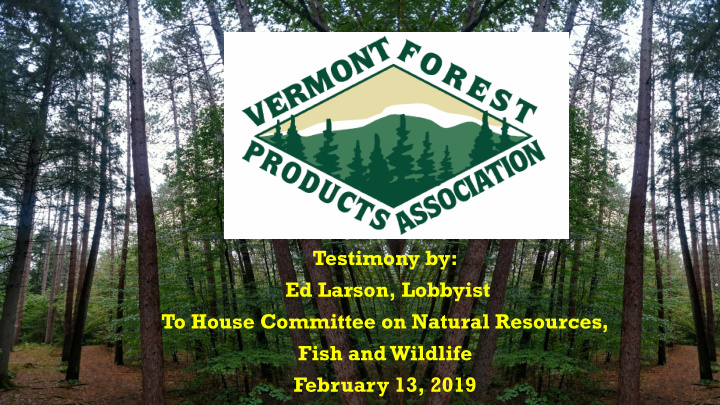



Testimony by: Ed Larson, Lobbyist To House Committee on Natural Resources, Fish and Wildlife February 13, 2019
The Commission recommends: · Criteria be added to protect forest blocks and connecting habitat from fragmentation by adopting the changes contained in H.233 of 2017. · The repeal of the exemption for farming, logging, and forestry below 2,500 feet when these occur in areas that have been designated as critical resource areas.
Addressing Gaps in Regulation Members of the Forestry Community want to know: What problems are we trying to solve? Is Act 250 the Answer? How will landowners respond? Who pays? What has happened since 1970?
Page 12 ( 45) “Critical resource area” means a river corridor, a significant wetland as defined under section 902 of this title, land at or above 2,000 feet, and land characterized by slopes greater than 15 percent and shallow depth to bedrock. The repeal of the exemption for farming, logging, and forestry below 2,500 feet when these occur in areas that have been designated as critical resource areas. The use of 2,000’ elevation to determine jurisdiction is arbitrary, as was establishing the 2,500 foot elevation
Major Federal Environmental Permit Programs: Clean Air Act (1970). Regulates emissions from stationary sources. Establishes national air quality standards. Clean Water Act (1972). Regulates pollutants from point sources, dredge and fill activities, and some stormwater discharges. Safe Drinking Water Act (1974). Regulates persons who provide drinking water to 25 or more persons. Resource Conservation and Recovery Act (1976). Regulates the generation, transport, storage, treatment, and disposal of hazardous waste. Comprehensive Environmental Response, Compensation, and Liability Act (CERCLA or Superfund) (1980). Major State Environmental Permit Programs: Vermont Water Pollution Control Act (Act 103 of 1973); Vermont Clean Water Act (Act 64 of 2015)*. Vermont Air Pollution Control Act (Act 212 of 1971)*. Vermont Waste Management Act (Act 78 of 1987)*; Universal Recycling Act (Act 148 of 2011). Vermont Safe Drinking Water Act (Act 71 of 1991)*. Vermont Flood Hazard Area, River Corridor and Stream Alteration Act (Act 138 of 2011). Vermont Shoreland Protection Act (Act 172 of 2013). Vermont Wetlands Permit
▪ Vermont Use Value Appraisal Program (UVA) (1979) Forest Management standards ▪ Acceptable Management Practices for Maintaining Water Quality on Logging Jobs in Vermont (AMPs) (1987) ▪ Heavy Cut Act 15 (1997) 40 acre jurisdiction ▪ AMPs requirement on UVA enrolled lands (added 2007) ▪ Chip Harvesting Requirements for Vermont Public Utilities ▪ Stream Alteration General Permit (2011). ▪ Voluntary harvest ▪ Licensed Foresters (2015) ▪ Voluntary Harvesting Guidelines For Private Landowners (2015) ▪ Multi-Sector General Permit sawmills and other forest product operations (Stormwater) ▪ Vermont Skidder Bridge Program
Since 2016 Forest fragmentation rate was only 2% over the previous 20 years (1/10 0f 1% per year). The rate of fragmentation is not increasing rapidly (Dr. Keeton). Rural permit applications are down Peter Gregory -Three Rivers Regional Planning Commission. Last Forest Integrity working group – no consensus on using Act 250 to regulate fragmentation.
VFPA Goals Keep landowners we have now, they know us • and we know them Encourage landowners to minimize • fragmentation thru education as they make decisions on what to do with their land. Improve business environment for the • industry to grow and thrive Forest Products Industry is the Solution Not just a part of the solution, but the solution • We can show them the money, sustainably • Wants landowners to participate in working forest • Forestland ownership is a major long term investment that has traditionally delivered a low yield return, but at least fairly stable. With a wide "bundle of rights", various values such as certain wood products, recreational use, and development options cycle up or down influenced by social and economic changes. The long-term trend has been a gradual increase in value, which is acceptable to long term investment. Landowners are growing a crop that takes 60-120 years to mature, and decisions are made on this timeframe. The continuing unpredictability of forest land taxation and regulation is also a major issue to be considered.
Statement of Concern
Borrowing Power College Retirement Additions Repairs Medical Family
Start a Business, Expand Increase Efficiency Improve Infrastructure
Upgrade Equipment Invest in Growth
EAST MIDDLEBURY FOREST East Middlebury, Addison County, VT 05740 PRICE: $279,000 ACRES: 178 TYPE: Multiple Uses AVAILABILITY: Available
Its all about equity
How is Vermont’s Forest Products Industry Doing?
Positive Changes to Act 250 Permit Conditions Hours of operation Transportation issues Noise, Residual storage such as sawdust and bark. Create new guidance document that builds flexibility for forest operation projects. • Prime Ag Soils and Fragmentation Mitigation A wood processing facility that would use 10,000 cords of wood annually (or equivalent) provides a service to 2,700 acres each year. The existence of this facility can conserve far more land than the mitigation requirement in current Act 250 law. Adjust or eliminate the need for mitigation requirements. •
Forest Landowner Needs • Stability • Predictability • Ability to make Choices One Example: Landowner Friendly Use Value Appraisal Program Use Value Appraisal has been a political football with much uncertainty, increasing costs and adding more regulations. The recent drastic increase in the Land Use Change Tax is one example. This was particularly directed at reducing forest fragmentation. How is that working out?
Thank you Ed Larson, Lobbyist Vermont Forest Products Association 117 Towne Hill Road Montpelier, VT 05602 802-224-9177 larsonthree@comcast.net
Recommend
More recommend